Imagine you’re all set to upgrade from your entry-level sports bike. Your key requirements would be sexy looks, enjoyable but not too much horsepower, and modern components. Two motorcycles that fit this bill rather well are the 2023 Kawasaki Ninja ZX-4RR (the only 400cc inline-four motorcycle on sale) and the Yamaha YZF-R7 (Team Blue’s latest entry in the much-contested mid-capacity sports bike class). Both promise a sub-80-horsepower peak output, similar underpinnings, and most importantly, a sub-$10,000 MSRP, all of which makes them uncanny contenders for your hard-earned money. But which one of these should you take home? Well, allow us to help with this quick comparison.
2023 Kawasaki Ninja ZX-4RR vs Yamaha R7 - Performance
The Kawasaki Ninja ZX-4RR employs a 399cc, inline-four screamer that whips out 75.9 horsepower (79-HP with ram air effect) and 26.5 pound-feet. Whereas, the Yamaha R7 boasts a 689cc, twin-cylinder engine (borrowed from the MT-07) to gush out 72 horsepower and 49 pound-feet. Looks like a clear win for the ZX-4RR with a four-horsepower advantage, right? Well, that’s not the case.
You see, all of the Ninja’s juice lies high up in the rev band, which is not exactly practical. On the flip side, the R7 has considerably more torque, all kicking in at 6,500rpm compared to the Ninja’s 11,000 figure, for a peppier and more tractable riding experience. Not to mention, the latter will feel more at home after jumping from an entry-level single or twin. To make matters worse, rumors suggest the US-spec Ninja ZX-4RR will be limited to just 56 horsepower, thanks to American emission norms.
2023 Kawasaki Ninja ZX-4RR vs Yamaha R7 - Underpinnings
The Kawasaki Ninja ZX-4RR hides a steel trellis chassis underneath, sprung on 37 mm Showa Big Piston upside-down forks and BFRC monoshock (both adjustable). This is topped by 17-inch alloy wheels, clamped by dual 290mm front discs and a 220mm rear disc (with Kawasaki calipers). Though an impressive combination, the Yamaha R7 one-ups the Kawasaki here. It features similar components, albeit with beefier 41 mm KYB upside-down forks and bigger brakes (298 mm front, 245 mm rear). Plus, the R7 even weighs the same as the Ninja (414 pounds), even though it's dimensionally bigger–pretty commendable if you ask us. Meanwhile, the Ninja ZX-4RR claws back some points, thanks to its lower seat height and shorter wheelbase–35 mm and 15 mm less than the R7, respectively. It will keep you on the road for longer too with its 15-liter tank (two more than the Yamaha).
2023 Kawasaki Ninja ZX-4RR vs Yamaha R7 - Features And Design
In terms of features, the Ninja ZX-4RR simply buries the Yamaha R7. That’s because the latter comes equipped with basic bits like a slipper clutch, all-LED lights, and a TFT dash for a no-frills experience. On the contrary, the baby Kawasaki takes direct inspiration from the Ninja ZX-10R to boast top-shelf electronics like four ride modes (Sport, Road, Rain, and Rider Customizable), three-mode traction control, two power modes, and a bi-directional quickshifter, all accessible via a 4.3-inch TFT instrument cluster. This display also lets you toggle between two display modes, smartphone connectivity, and a lap timer.
Features aside, we believe it’s the Yamaha R7 that looks better among the two sports bikes. Not only is it sleeker-looking (Yamaha R6 inspiration for the win!), but you also get wider tires for better road presence. Also, Yamaha offers it in three colors - white, black, blue - while Kawasaki has the KRT livery on offer.
2023 Kawasaki Ninja ZX-4RR vs Yamaha R7 - Price And Verdict
This is where the R7 makes the most sense. Yamaha has priced it at $9,199–$500 less than the Ninja ZX-4RR–which we believe is a big enough difference to look past the R7’s setbacks. Plus, with the money you save, you can invest in an exhaust or perhaps a quickshifter to increase power or make life easier, respectively. So if you’re upgrading from, say a 250cc or 300cc motorcycle, the Yamaha is a better investment than the Kawasaki money-wise. It’ll keep you happier with the “big bike” feel and usable power delivery. That said, if money isn’t a problem, the Ninja ZX-4RR will be a cracking pocket rocket for sure. We expect it to have a cult following in the coming years, and it’ll probably become a superstar in the used market once it flies off the shelves. Let us know what you’d pick in the comments below!




